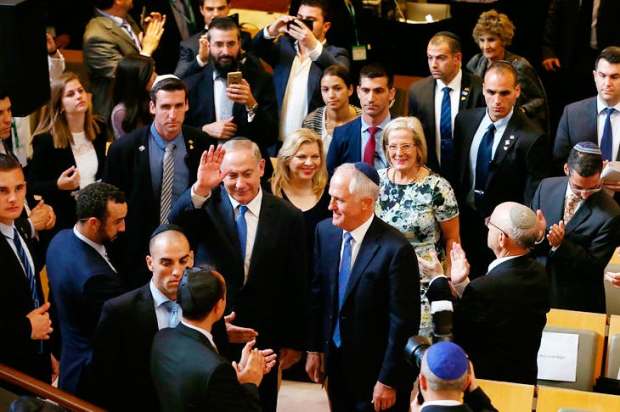Advice to new graduates from an old Chief Justice of Australia, Murray Gleeson: ‘To think against the spirit of the age you must have courage. To speak against it you must be mad. The purpose of a good education is to make us a little mad.’ (At the 2013 graduation ceremony, Campion College.)
In the Author’s Note in Lazarus Rising, John Howard devotes seven pages to staffers who helped him in his career. The adjectives tell the story: ‘savvy’ (Arthur Sinodinos), ‘gifted’ (Tony Nutt), ‘indispensable’ (Barbara Williams) and many more (loyal, astute, thoughtful, well-loved). He also thanks Gerard Henderson, his chief of staff for a couple of tempestuous years in the 1980s. Henderson, he says, ‘worked hard’. He also offered ‘intelligent counsel’. This does not quite tell the full story. Their association began late in 1983 after Henderson wrote his famous polemic, ‘The Industrial Relations Club’. It ended some two years later in what Paul Kelly called ‘a blazing row’. The Industrial Relations Club was that cosy ring of insiders (unionists, employers, arbitration commissioners) who settled industrial disputes according to arcane principles untroubled by economic realities such as capacity to pay. The Club, Henderson said, was sending businesses broke and putting Australians out of work. As editor of Quadrant at the time I readily published Henderson’s article and gave an early copy to Howard so that he might draw on it in his forthcoming address to the National Press Club. That speech, with its critique of the IR Club, became a landmark in the story of industrial relations reform. Soon after Howard offered Henderson a job, which he gladly accepted since his own future in the department of industrial relations was now uncertain.
But there was an inevitable tension between gung-ho Henderson and cautious Howard. After a couple of years, Henderson left to start his Sydney Institute. In his new monograph, The Return of the Industrial Relations Club, Henderson tells his side of the story and draws a lesson or two for Tony Abbott. In government after 1996, Howard, Peter Costello and Peter Reith finished off the IR Club. But the Rudd and Gillard governments quickly restored it to its former glory — bolstering union bosses, reregulating industrial relations, downplaying productivity and ignoring the unemployed and underemployed. Henderson does not expect Tony Abbott to take on the Club immediately. But its reactionary ethos ‘should be challenged’ — even if it ends in another ‘blazing row’.
Talking about Quadrant, a letter to the editor caught my eye in the December issue. It is by Evan Williams, formerly of the New South Wales Cabinet Office in the Carr government. His letter is about the foundation of Australia in January 1788. Back in 2001, the London-based Australian lawyer Geoffrey Robertson convinced Premier Carr that he should exhume Arthur Phillip’s remains from his grave in St Nicholas Church, Bathampton, and rebury them in Sydney. Carr asked Williams to look after the details! The Bishop of Bath and Wells gave the project his blessing and in Sydney the Royal Botanic Gardens Trust agreed to set aside a new burial site beside the Harbour. The plan included exhuming, repatriating and reburying beside Phillip the remains of the young Aborigine, Yemmerrawannie, whom Phillip had taken to England (where he died of pneumonia in 1795). The reburials would symbolise Reconciliation. A great monument was to mark the spot. (One suggestion was something on the scale of the Statue of Liberty!) The project had its critics including indigenous apparatchiks who have long attacked Phillip as the archetypical enemy invader — ever since the anti-British neofascist P.R. Stephensen promoted that idea against the self-congratulatory Australian plebs and bourgeoisie at the time of the 1938 Sesquicentennial celebrations. But what really killed the idea was the sponsors’ inability to find Phillip’s remains. Were they under the floor of St Nicholas Church or somewhere in the grounds? To locate them, Williams writes, would have been a big operation ‘with little prospect of success’ (although as ABC chairman James Spigelman put it dryly when launching Michael Pembroke’s acclaimed biography Arthur Phillip: ‘If we can find Richard III, I suppose we can find Phillip.’)
But the Carr government abandoned its plan and the principal monument to Phillip in Sydney remains the huge statue in the Royal Botanic Gardens commissioned by Premier Henry Parkes in the 1890s at a cost to taxpayers, in today’s currency, of about $1.5 million — more than we squandered on Jackson Pollock’s overvalued, abstract expressionist ‘Blue Poles’. But all is not lost. Later this year — on the 200th anniversary of Phillip’s death in Bath — the Britain-Australia Society will commemorate his life and work by installing a plaque, made from Sydney sandstone, in the floor of the main aisle of Westminster Abbey, and reinstalling, in St James’ Church, Sydney, the stone displaced from the Abbey’s floor. The events will be in the presence of descendants of George III and Professor Marie Bashir, vice-regal descendant of Governor Phillip. The Society will also establish a continuing bursary for scholarships to encourage the study of ‘two great nations with a shared heritage’. It all makes a change from the old days when many Australians felt that English authorities barely acknowledged what Pembroke calls Phillip’s ‘grand vision’ of Australia. It was as if, in Spigelman’s wry judgment, we were just ‘too successful for our own proper station in life, of which we need to be reminded from time to time’.
Got something to add? Join the discussion and comment below.
Get 10 issues for just $10
Subscribe to The Spectator Australia today for the next 10 magazine issues, plus full online access, for just $10.
You might disagree with half of it, but you’ll enjoy reading all of it. Try your first month for free, then just $2 a week for the remainder of your first year.














Comments
Don't miss out
Join the conversation with other Spectator Australia readers. Subscribe to leave a comment.
SUBSCRIBEAlready a subscriber? Log in